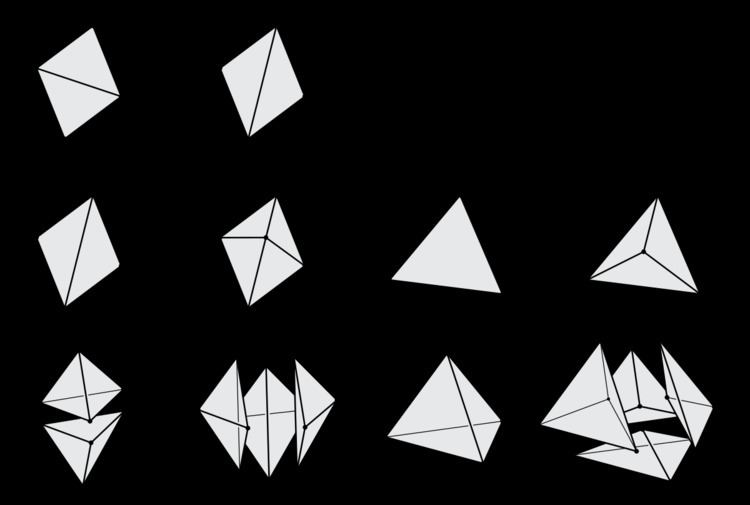 | ||
A flip graph is a graph whose vertices are combinatorial or geometric objects, and whose edges link two of these objects when they can be obtained from one another by an elementary operation called a flip. Flip graphs are special cases of geometric graphs.
Contents
- Examples
- Finite sets of points in Euclidean space
- Topological surfaces
- Other flip graphs
- Polytopality
- Connectedness
- References
Among noticeable flip graphs, one finds the 1-skeleton of polytopes such as associahedra or cyclohedra.
Examples
A prototypical flip graph is that of a convex
This basic construction can be generalized in a number of ways.
Finite sets of points in Euclidean space
Let
and
Topological surfaces
Another kind of flip graphs is obtained by considering the triangulations of a topological surface: consider such a surface
In this setting, two triangulations of
Two triangulations are related by a flip when they differ by exactly one of the arcs they are composed of. Note that, these two triangulations necessarily have the same number of vertices. As in the Euclidean case, the flip graph of
The flip graph of a surface generalises that of a
Other flip graphs
A number of other flip graphs can be defined using alternative definitions of a triangulation. For instance, the flip graph whose vertices are the centrally-symmetric triangulations of a
Flip graphs may also be defined using combinatorial objects other than triangulations. An example of such combinatorial objects are the domino tilings of a given region in the plane. In this case, a flip can be performed when two adjacent dominos cover a square: it consists in rotating these dominos by 90 degrees around the center of the square, resulting in a different domino tiling of the same region.
Polytopality
Apart from associahedra and cyclohedra, a number of polytopes have the property that their 1-skeleton is a flip graph. For instance, if
Connectedness
Polytopal flip graphs are, by this property, connected. As shown by Klaus Wagner in the 1930's, the flip graph of the topological sphere is connected. Among the connected flip graphs, one also finds the flip graphs of any finite 2-dimensional set of points. In higher dimensional Euclidean spaces, the situation is much more complicated. Finite sets of points of
It is yet unknown whether the flip graphs of finite 3- and 4-dimensional sets of points are always connected or not.
